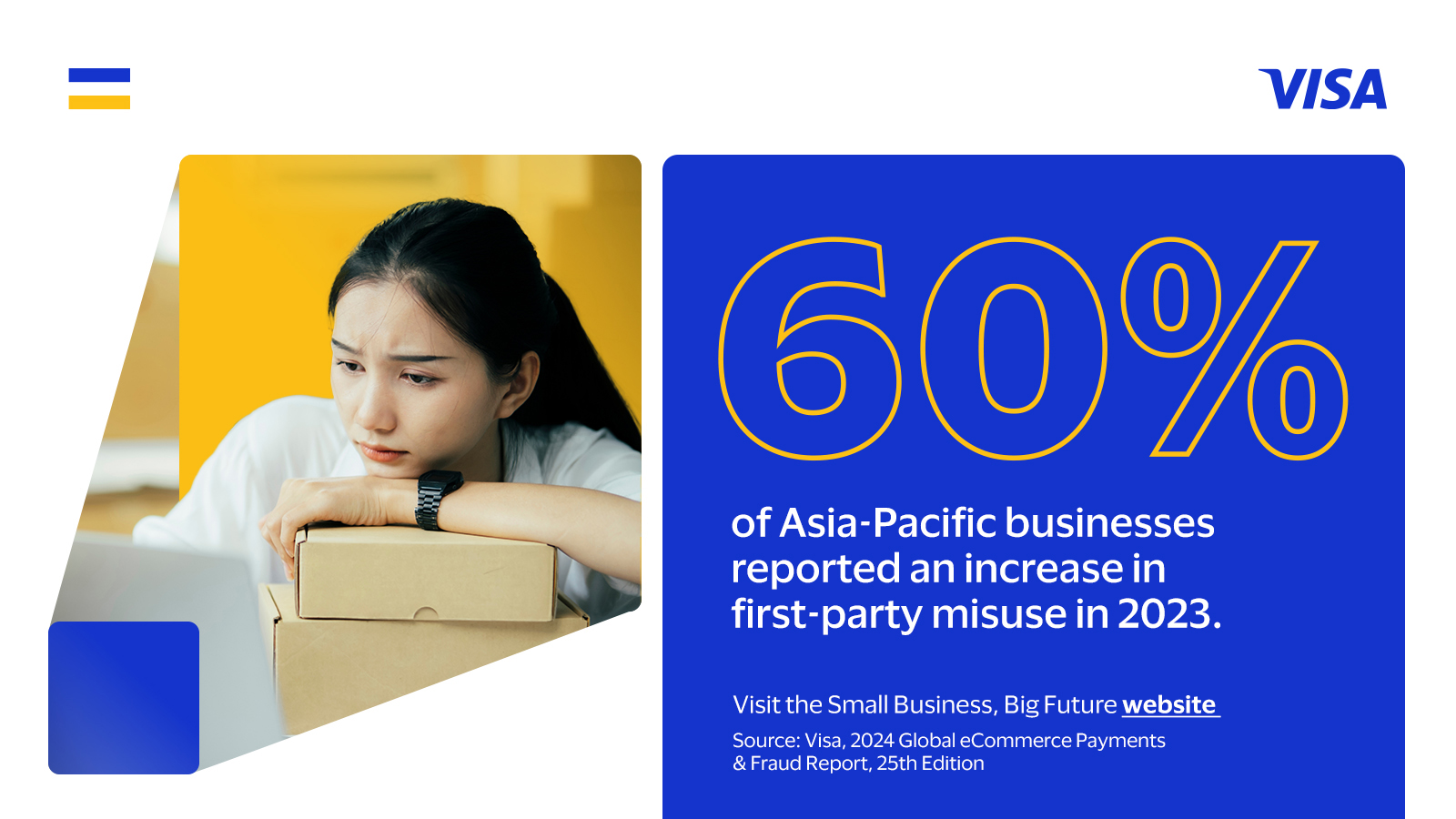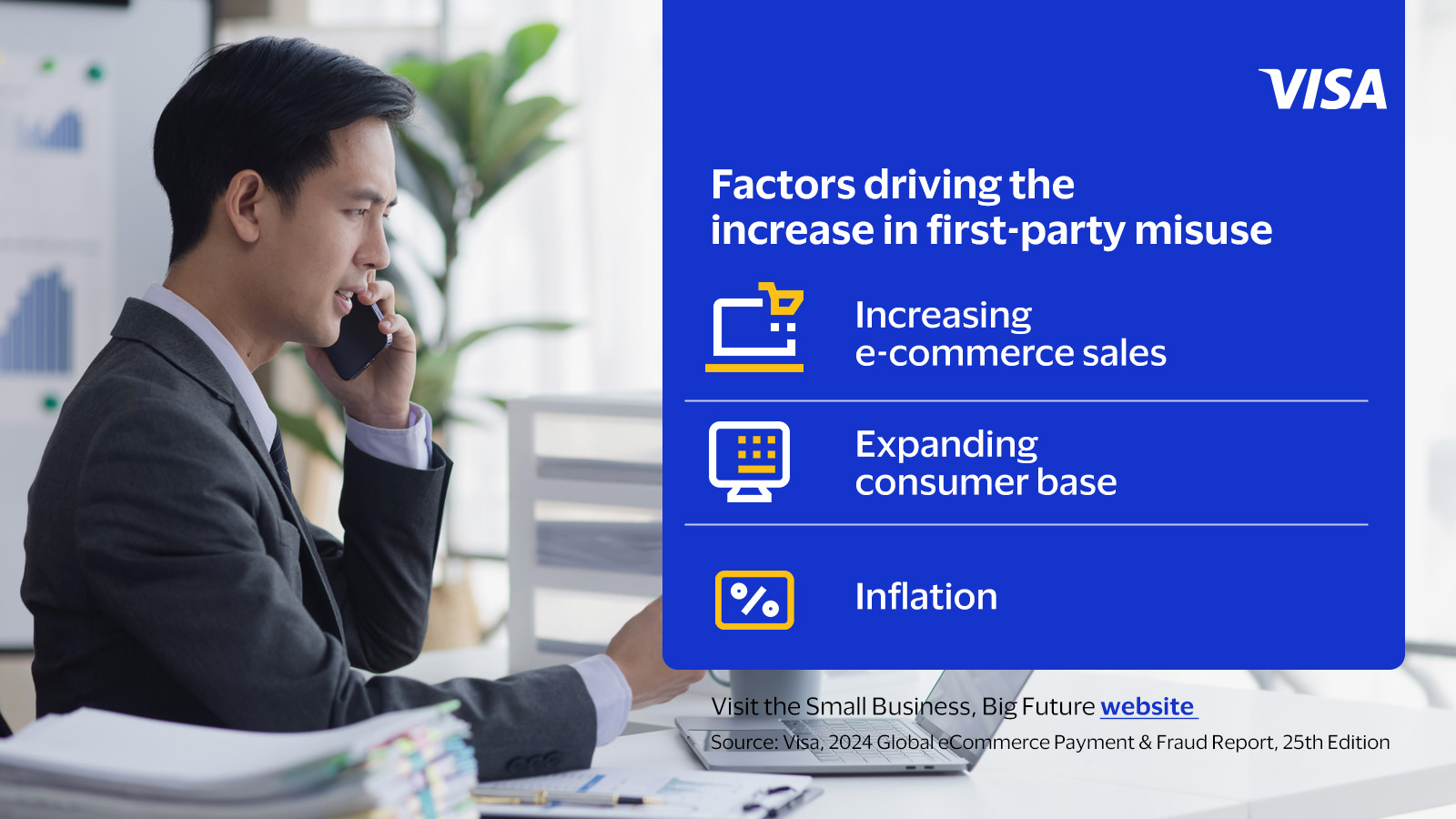

Fraud in Focus – The rise of first-party misuse and how SMBs can overcome this

Common fraudulent activities include exploiting return policies, making false claims such as purchases not being delivered, and manipulating seller policies to gain undeserved financial advantages. Factors such as increasing e-commerce orders, inflation, and the expansion of new consumer bases contribute to the rise in first-party misuse.² For SMBs, which often operate with limited margins and depend heavily on consumer trust and satisfaction, fraudulent activities like unwarranted chargebacks and deceitful refund claims can lead to substantial financial losses and erode consumer trust.
The complexity of first-party misuse
First-party misuse is often trickier to handle than threats like phishing, pharming, and whaling due to its complex nature. Incidents are challenging to detect and prevent because they originate from actual consumer interactions rather than external malicious actors. SMBs face several considerations when it comes to handling first-party misuse:
1. Legitimacy of initial transaction
First-party misuse occurs through transactions that initially appear legitimate, making it difficult for businesses to distinguish between genuine consumer behaviour and potential fraud at the point of sale. For example, a consumer might purchase a high-value item, then later claim it arrived damaged or not at all, demanding a refund or replacement. It can be challenging to tell whether this claim is fraudulent or not.
2. Risk to consumer relationships
Addressing first-party misuse requires delicate handling to avoid alienating genuine consumers. SMBs must balance fraud prevention with maintaining a positive consumer experience, which can complicate response strategies. Falsely accusing consumers of fraud can lead to a loss in brand reputation. On the other hand, overlooking a fraudulent incident can cause financial losses.
3. Detection complexity
Unlike phishing or pharming, where security measures can detect and block fraudulent attempts from external sources, first-party misuse involves analysing consumer behaviour patterns and transaction histories. This requires sophisticated data analysis tools and can lead to false positives. Furthermore, such tools might also not be accessible to SMBs with limited resources.
4. Legal and chargeback issues
First-party misuse often results in chargebacks, where resolving disputes can be legally intricate and time-consuming. SMBs must navigate the complex chargeback process, often without clear evidence to dispute consumers’ claims effectively. Without guidance, SMBs could be robbed of their time and focus and lose track of their core business.

Proactive measures to combat first-party misuse for SMBs
To mitigate the impact of first-party misuse, SMBs can adopt several strategies focused on early detection and prevention.
Firstly, ensuring that payments are processed with advanced security tools is essential. Enforcing strong security measures such as encryption and secure payment gateways can help provide protection. Further, utilising services that offer continuous monitoring and real-time alerts for unusual transaction activities can help SMBs catch fraud early. Additionally, implementing dedicated support and resources for dispute resolution and fraud prevention allows SMBs to handle issues effectively.
Secondly, pre-empting fraudulent transactions with data tools can significantly reduce risk. For this, SMBs should rely on the support of digital ecosystem players like payment networks and issuers to ensure that transaction risks are assessed accurately and mitigated promptly. For instance, they can leverage guidelines, such as Visa’s Compelling Evidence 3.0, to better dispute chargebacks and recover losses from first-party misuse.³ The guidelines help reduce chargeback volumes, decrease ambiguity during disputes, and make the resolution process more seamless. In addition, SMBs can also use technologies like Visa Advanced Authorisation and Visa Risk Manager to proactively identify and mitigate first-party misuse cases with the help of AI.⁴
Lastly, partnering with the right platforms and security networks can provide substantial benefits. SMBs can gain access to specialised knowledge and technological resources by working with platforms known for their fraud prevention capabilities. Joining security networks that provide insights into fraud trends and threat intelligence allows SMBs to stay ahead of new fraud techniques. Furthermore, these platforms and security networks can guide SMBs to comply with financial regulations. They have the knowledge to provide guidance on best practices for handling disputes and chargebacks to enhance fraud prevention efforts further.
First-party misuse poses a significant challenge for SMBs in the Asia Pacific region. To effectively turn the tide, SMBs and the broader financial ecosystem must recognise the complex nature of this fraud and refine detection efforts with nuanced indicators of fraudulent activities. Detecting these threats requires comprehensive, AI-powered fraud risk management solutions that offer real-time transaction analysis and behavioural analytics. By forging partnerships and accessing shared insights on fraud trends, SMBs can adopt a collective defence strategy against this growing threat.
¹ Visa, Enhancing Small and Medium-Sized Business (SMB) Financial Security and Fraud Prevention, 2024.
² Visa, Enhancing Small and Medium-Sized Business (SMB) Financial Security and Fraud Prevention, 2024.
³ Visa, Compelling Evidence 3.0 Merchant Readiness, 2023.
⁴ Visa, Visa Advanced Authorisation and Visa Risk Manager, accessed May 2024.